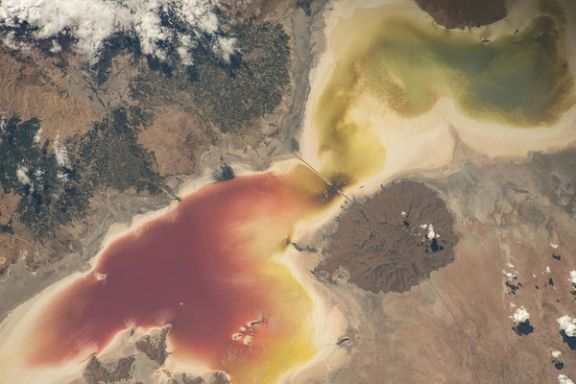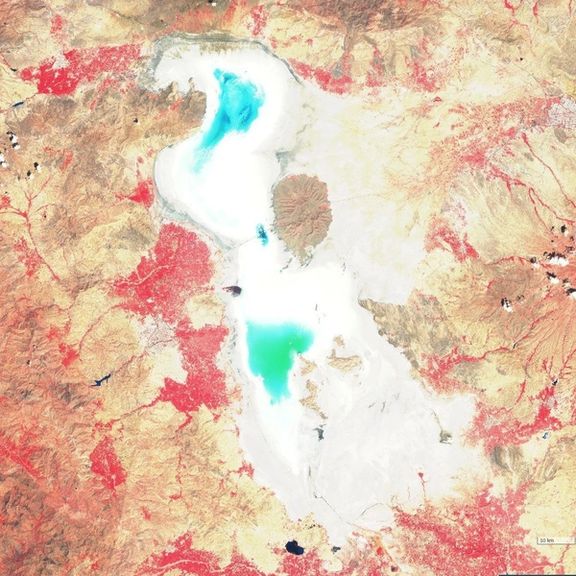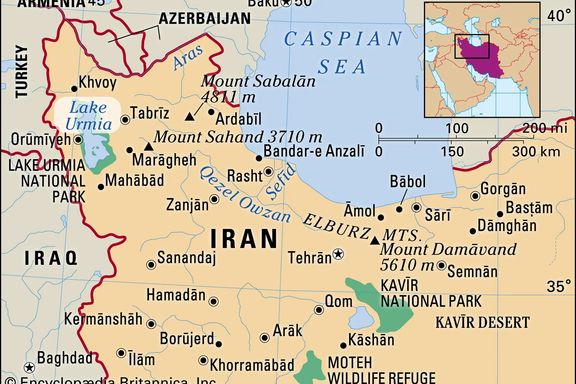Iranians Protest Government Negligence As Lake Urmia Dries Up

Iranians held a demonstration in the northwestern city of Tabriz on Saturday to protest mismanagement that has led to the disappearance of Lake Urmia.

Iranians held a demonstration in the northwestern city of Tabriz on Saturday to protest mismanagement that has led to the disappearance of Lake Urmia.
The protesters gathered outside the provincial office of Iran’s Natural Resources and Watershed Management Organization, demanding the reopening of dams on rivers that feed the lake to resuscitate the dying hypersaline body of water.
Located between the provinces of East Azarbaijan and West Azarbaijan in northwestern Iran, Lake Urmia (Orumiyeh) was the largest lake in the Middle East and the sixth-largest saltwater lake on Earth with an original surface area of 5,200 square kilometers in the 1970s, or 2,000 square miles. It had shrunk to 700 sq km by 2013. The lake began shrinking in the 1980s due to water mismanagement and climate change.
During the demonstration, people chanted slogans such as "Lake Urmia is thirsty" and "Break the dams, fill Lake Urmia." In July 2022, a protest was also held and police arrested an unknown number of activists.
Once a thriving tourist hotspot with bustling hotels lining its shores and commercial ferries plying its waters, the lake currently hovers on the brink of utter disappearance. This dire situation is the result of a combination of factors, including prolonged droughts, excessive water consumption by local communities, and the ill-conceived construction of dams along its tributaries, all exacerbated by the regime's neglectful approach.

Experts say excessive and illegal groundwater extraction and using the water of the once bountiful Zarrineh Rud − which feeds Urmia Lake − for irrigating apple trees have both contributed to the lake shrinking by nearly 95 percent in volume over the past 20 years. In 2021 alone, more than 100,000 tons of apples of the province’s production went to waste.
Recent images capturing the last gasps of the lake depict a stark portrayal of its complete extinction and the severe environmental repercussions in the region. Nevertheless, regime officials still defend their actions with several phantasmagorical visions.
Ali Salajegheh, a vice president and the head of Iran's Department of Environment Protection, said during his visit to the region that “We hope that with substantial autumn rainfall, the situation of Lake Urmia will improve.”

His claims came a day after Ramezan Sharif, the spokesperson of the Islamic Revolutionary Guard Corps (IRGC), described the public concern over the dying lake as an attempt by the critics of the regime to "undermine the authority of the Islamic Republic.” He claimed that "over the past 800 years, several lakes like Lake Urmia have dried up around the world, and these specific climate changes are not unique to Iran."
Fars news agency, affiliated with the Revolutionary Guard, quoted Salman Zaker – representative of the city of Orumiyeh in the parliament -- as saying on Saturday that the private sector can play a constructive role in saving the lake. "This is a demand shared by the public at large, and the government should engage the private sector in this endeavor. Thousands of residents of the region are eager to contribute to saving Lake Urmia by participating in the water transfer project from the Caspian Sea,” he said.
His remarks showed the attitude of regime insiders who make grandiose and baseless statements. Transferring water from the Caspian Sea hundreds of kilometers away would be a herculean task.

“Approximately 28 solutions have been considered for the revival of Lake Urmia," he said, claiming that “The results of the measures taken to revive Lake Urmia may not yet be tangibly evident... However, these actions can gradually lead to positive outcomes for the lake.”
Etemad, one of Tehran's prominent reformist dailies, said in an opinion piece on Saturday that studies indicate even the release of water from all upstream dams cannot revive Lake Urmia. Citing a study by researchers at Tehran’s Sharif University, the article said, "The water level of Lake Urmia on June 3, 2023, reached its lowest recorded level since measurements began, and now the volume of water is even lower than in 2015, the year when the lake's condition was announced as critical.”
In May, the former head of Iran's Environment Protection Organization warned that four million Iranians risk displacement if Lake Urmia dries up. “Transferring the residents of Tabriz to another place requires $500 billion while the cost of reviving the lake is about one billion dollars,” Issa Kalantari said, explaining that the salt dust would be unbearable for residents in Tabriz and its surrounding cities.

Last year, when the lake had shrunk by 95 percent, he said the fate of the Iranian regime is contingent on saving the lake. If the lake is not restored, it will have security consequences, and no government can survive in the country because it cannot withstand the flood of migration of millions of people who reside in the surrounding regions, he said.
The government of President Hassan Rouhani appropriated 150 trillion rials – in 2014 – equivalent to one billion dollars at the time - for a seven-year plan as well as another $10 million aid by Japan and some other pledges by the United Nations Food and Agriculture Organization (FAO) and the United Nations Development Program (UNDP) to save the lake. It is not clear whether or how the earmarked budgets were spent.